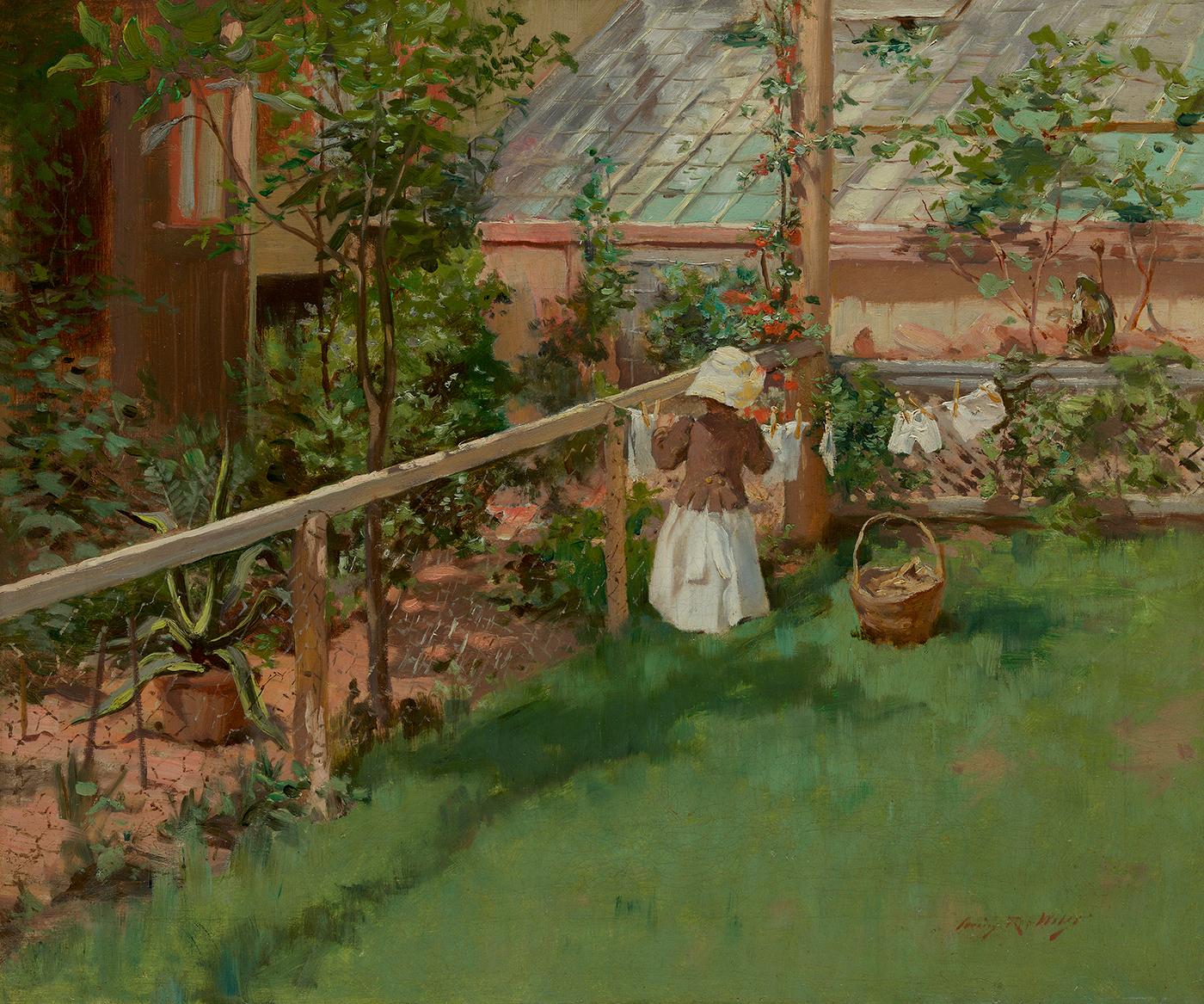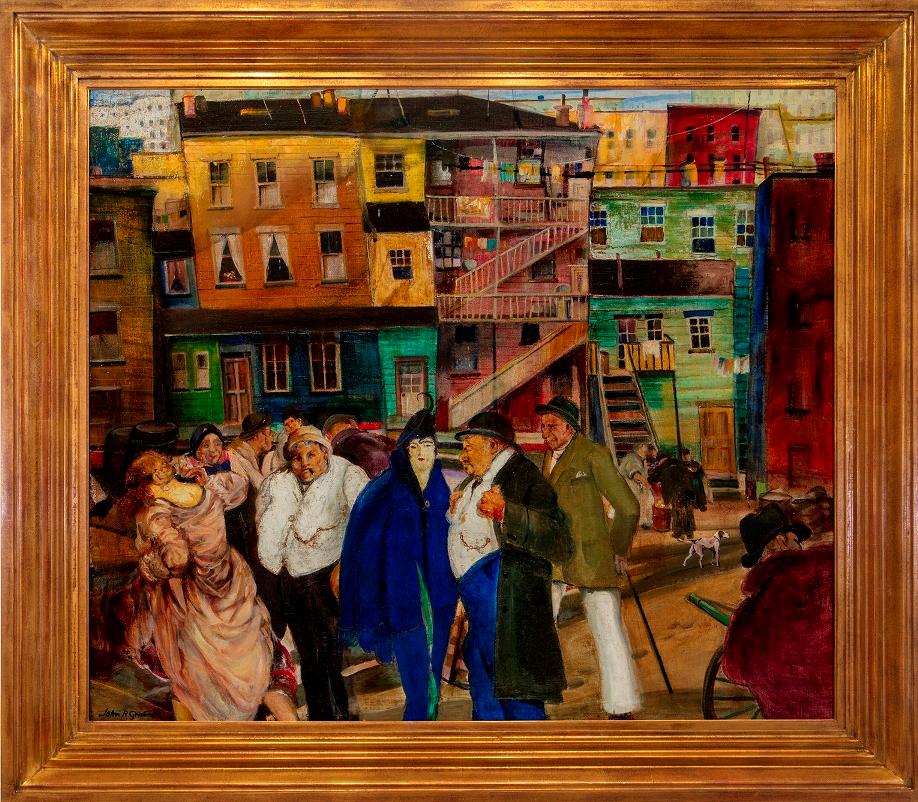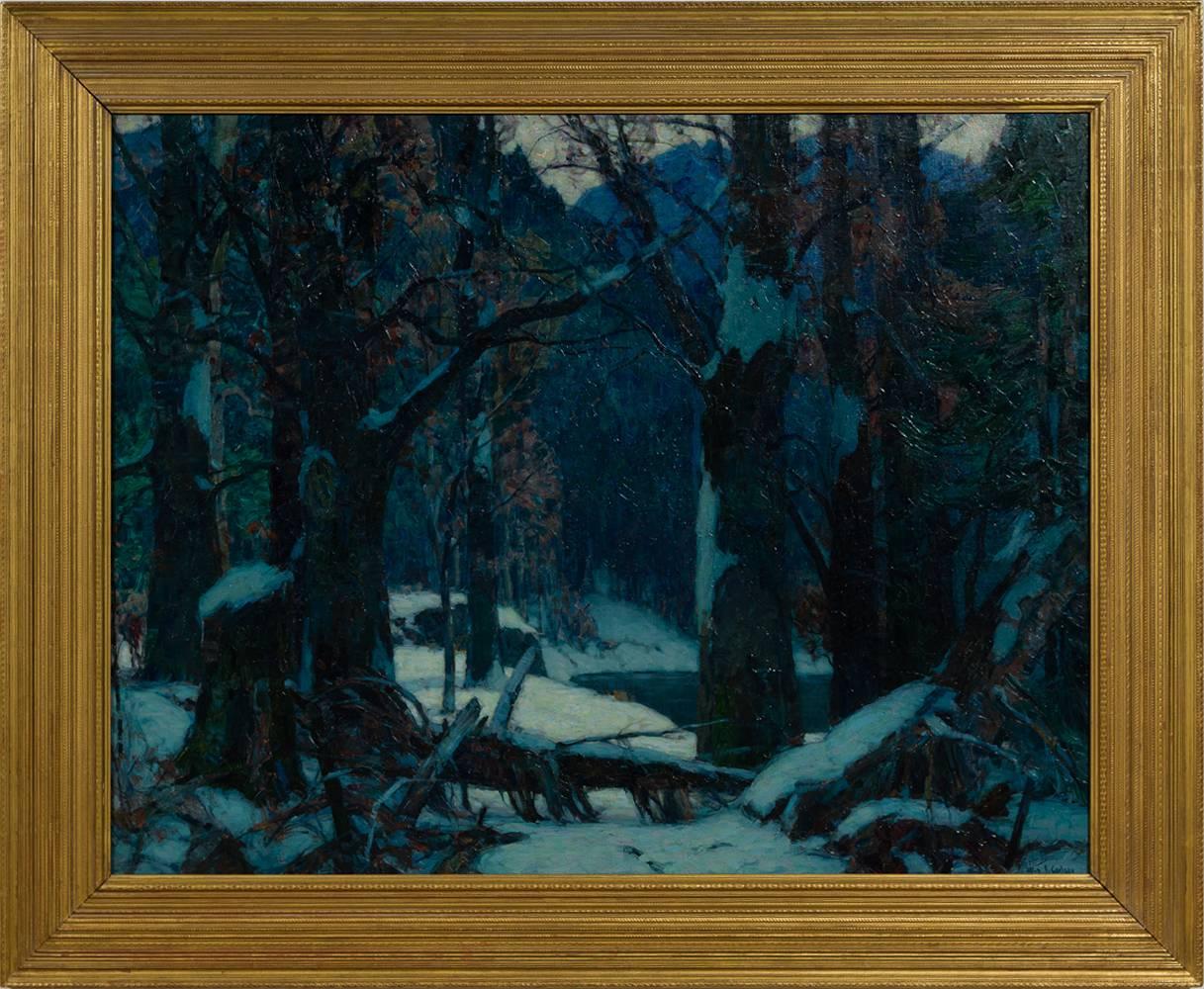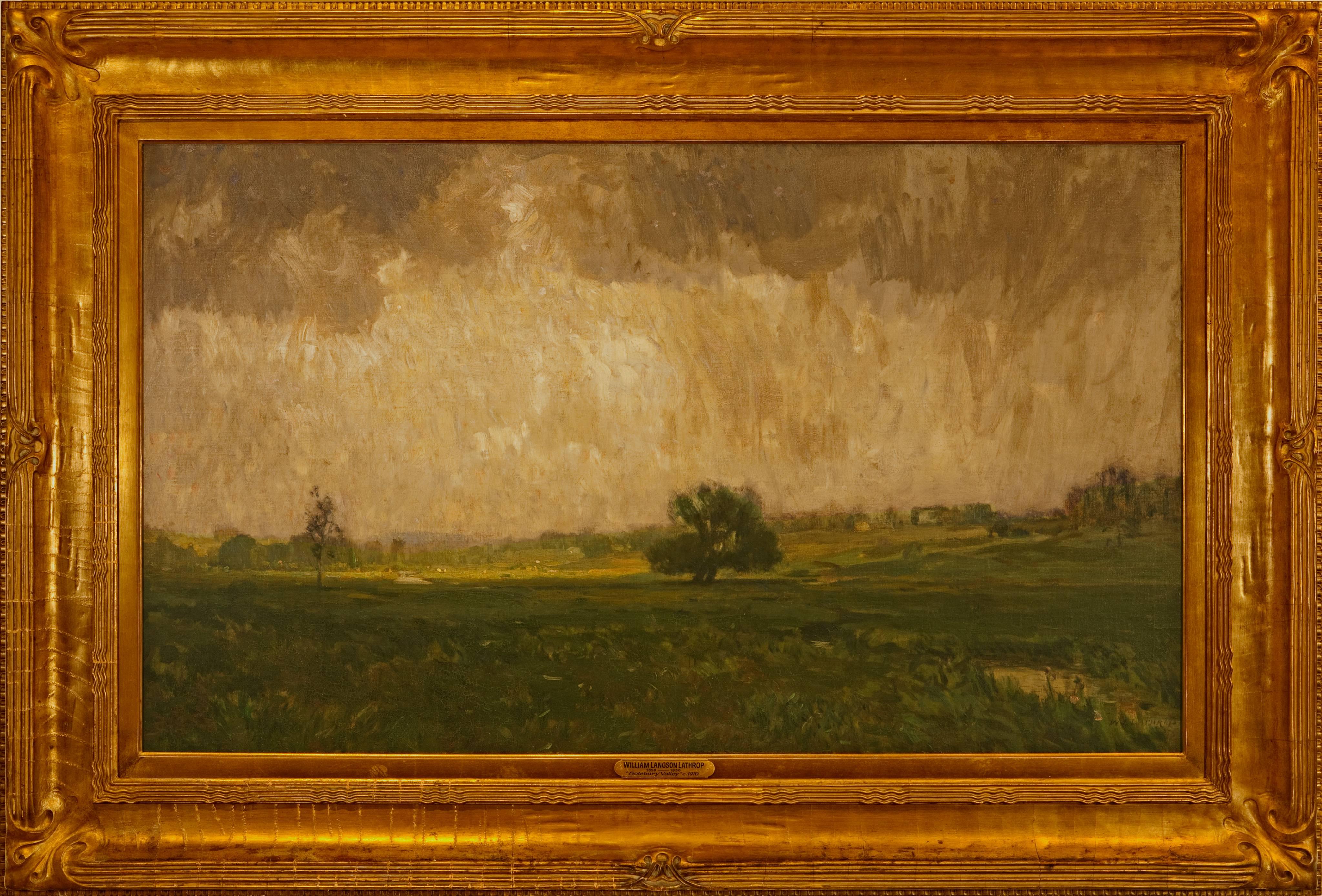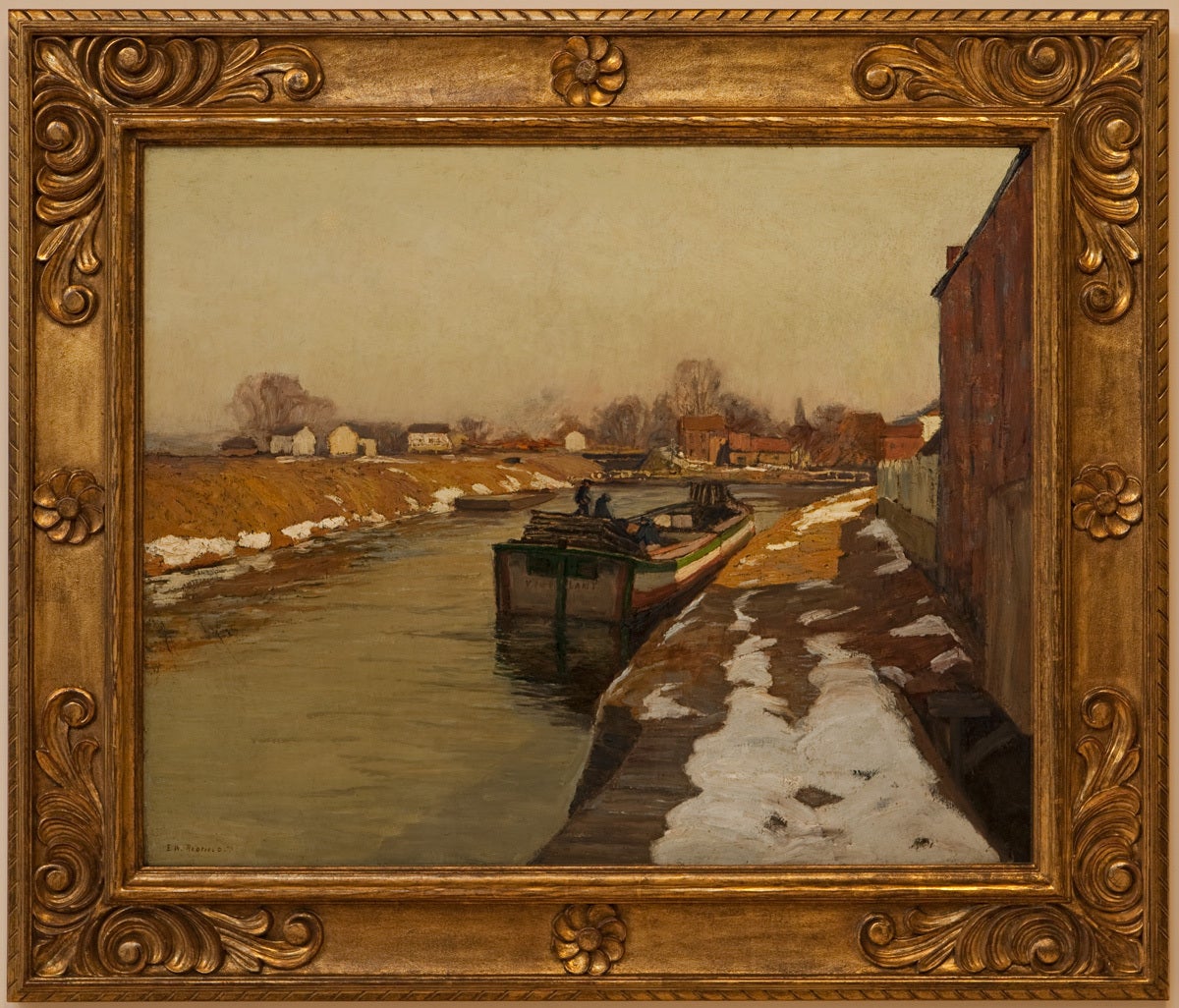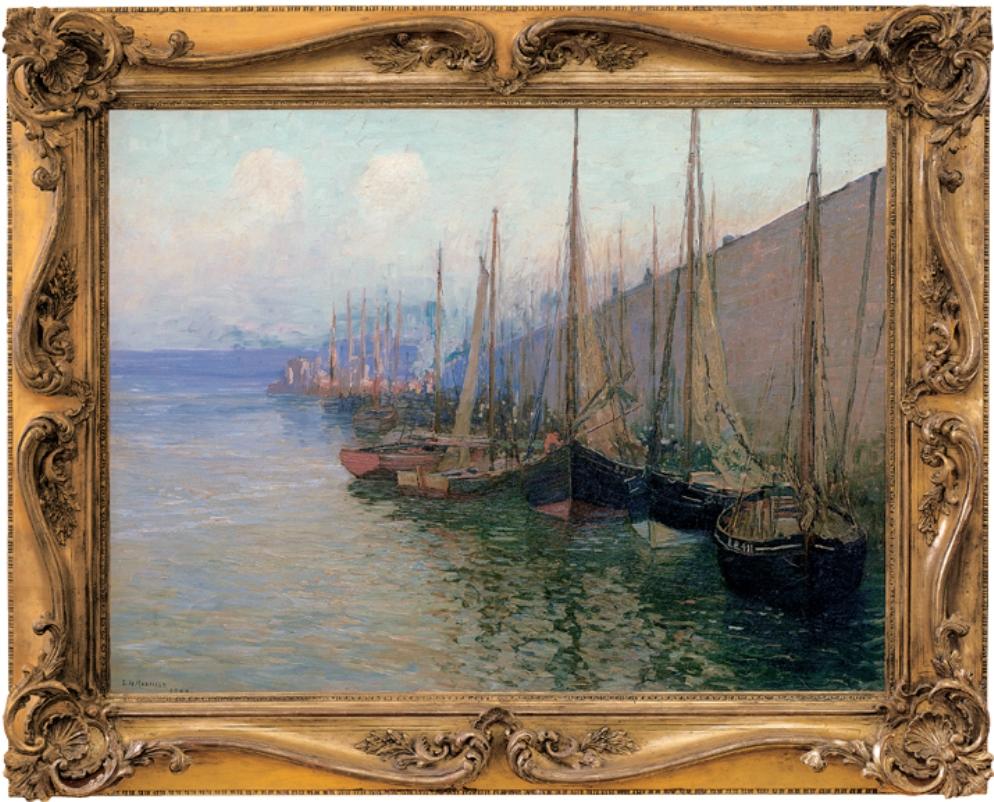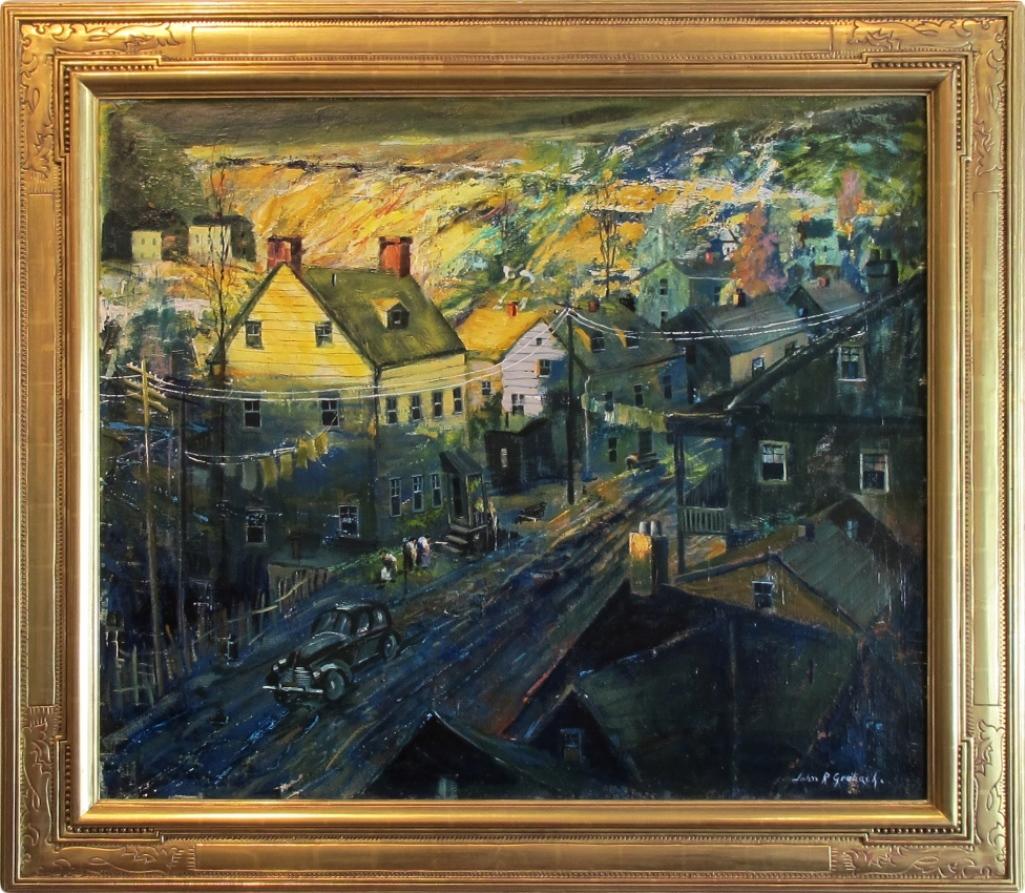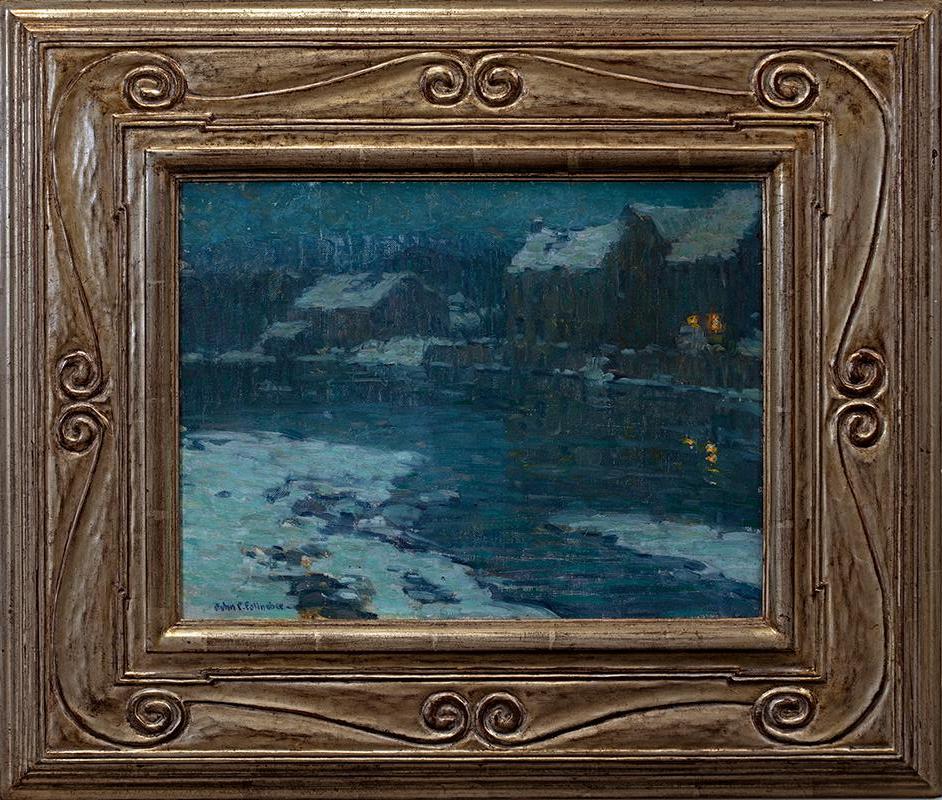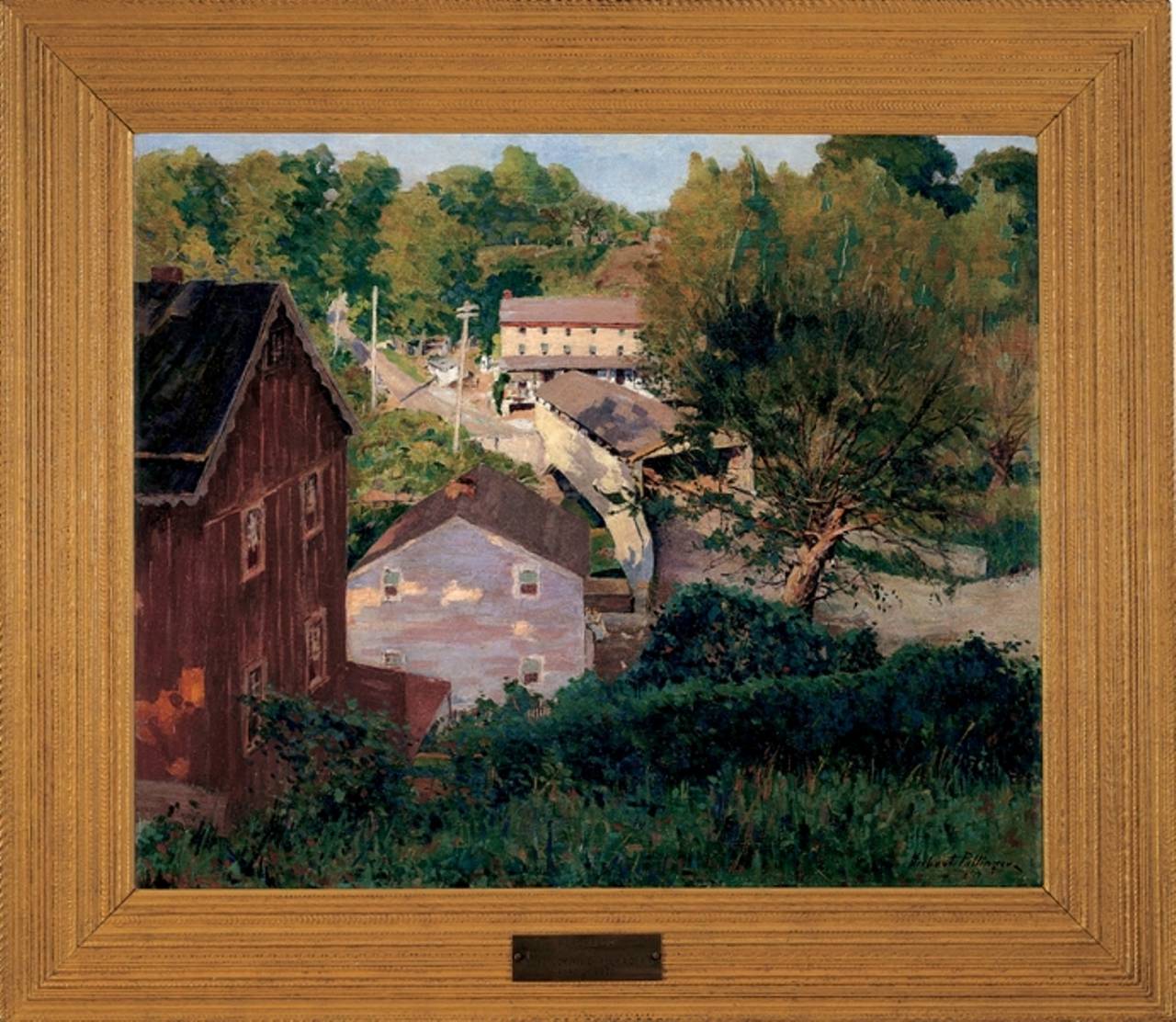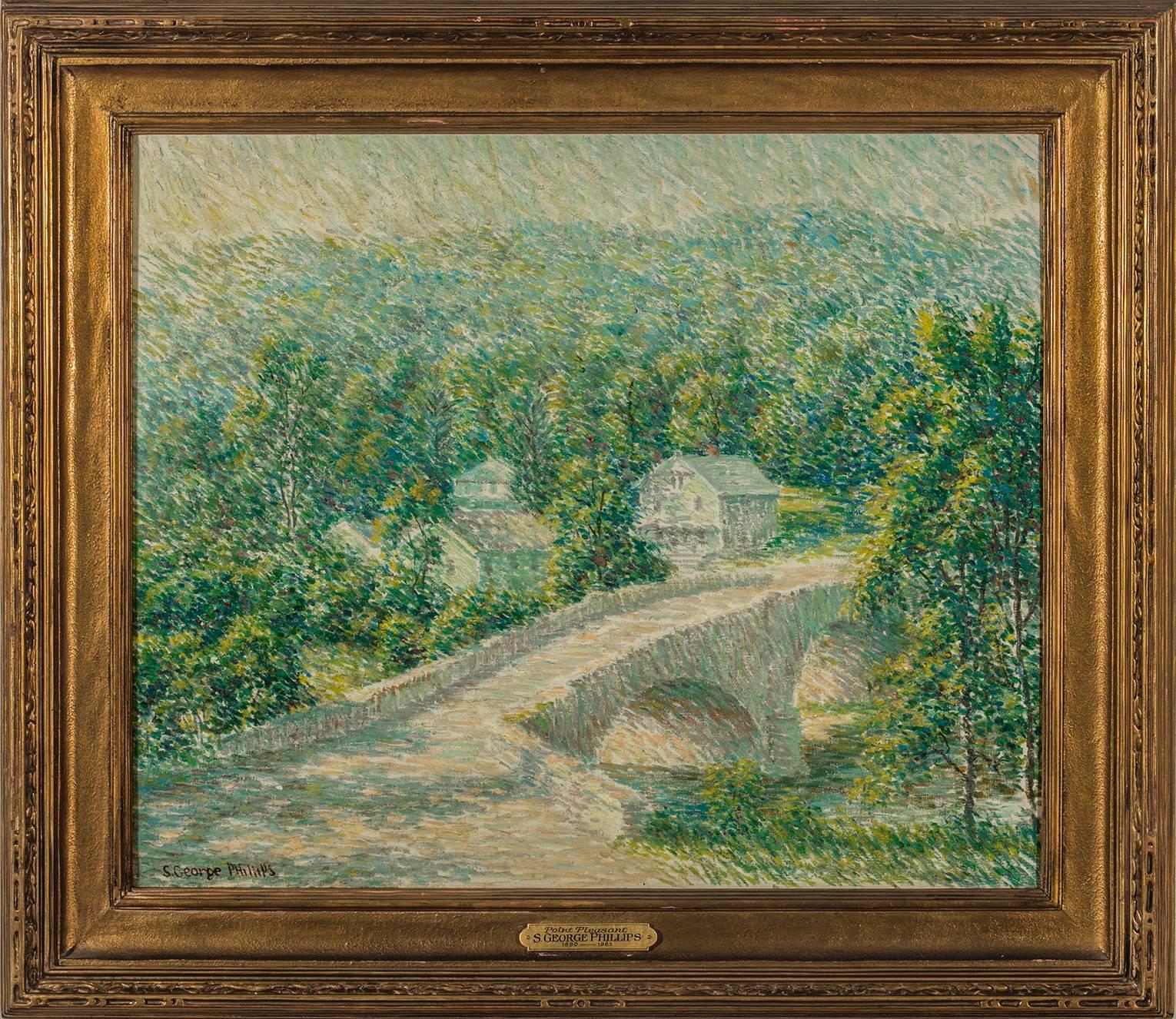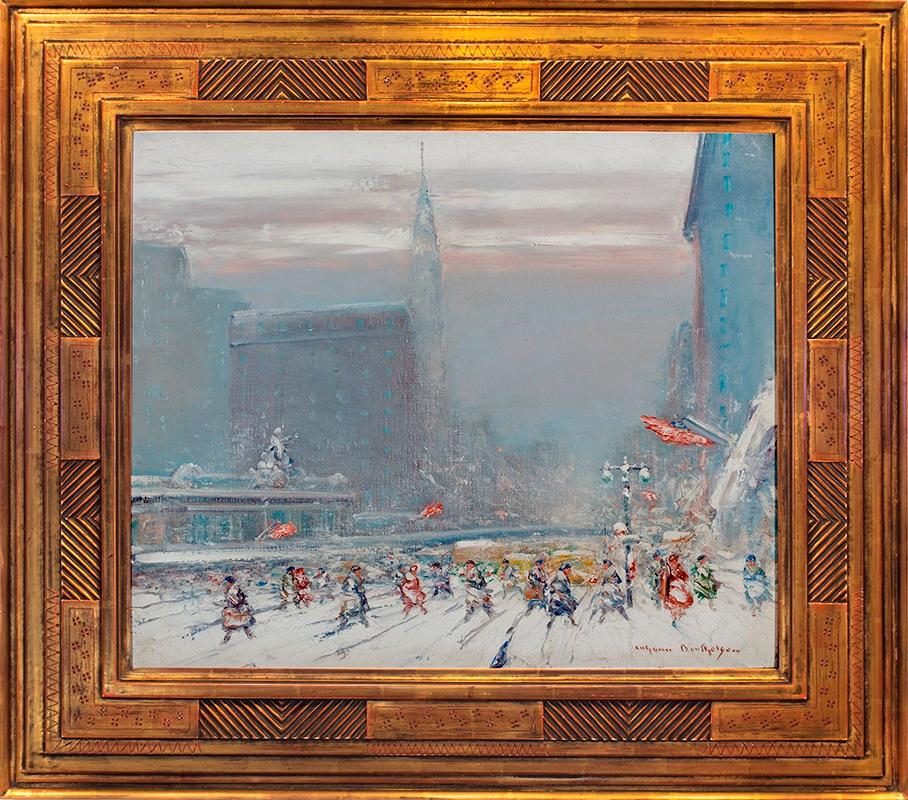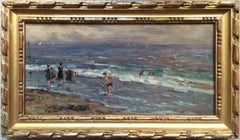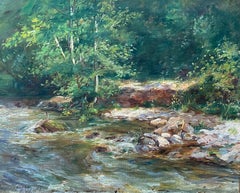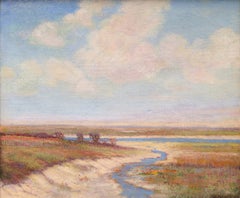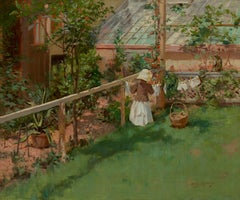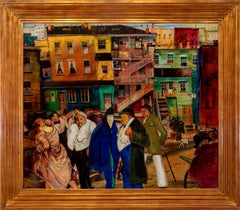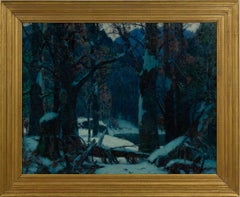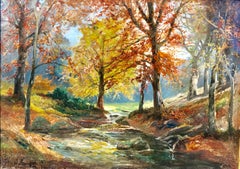
“Early Autumn, Bronxville Woods”
View Similar Items
Want more images or videos?
Request additional images or videos from the seller
1 of 11
George Henry Smillie“Early Autumn, Bronxville Woods”Circa 1910
Circa 1910
About the Item
- Creator:George Henry Smillie (1840 - 1921, American)
- Creation Year:Circa 1910
- Dimensions:Height: 22 in (55.88 cm)Width: 30 in (76.2 cm)Depth: 2.5 in (6.35 cm)
- Medium:
- Movement & Style:
- Period:
- Condition:
- Gallery Location:Southampton, NY
- Reference Number:1stDibs: LU1413816212
George Henry Smillie
The career of George Smillie followed the arc of nineteenth-century U.S. landscape painting. Trained in the Hudson River School tradition, Smillie successfully adapted to changing U.S. tastes and growing interest in European trends. In the late 1800s, he moved to tonalist paintings full of brushwork and influenced by French Barbizon painting. By the end of his career, he had lightened his palette to produce works similar to those of the U.S. impressionists. Yet in all styles, he was never less than competent, and his tonalist work is among the best produced in the United States. Like many nineteenth-century painters, George Smillie’s artistic training began with the study of printing. His father, James Smillie, was a noted printmaker who engraved Hudson River landscapes. George studied briefly with James McDougal Hart and then opened a studio of his own in New York City. A critic in 1870 said that his realistic landscapes exhibited “a certain refinement” that “enhances the charm of his more quiet scenes.” Smillie spent most of his career in New York City but sketched for several summers in New Hampshire, upstate New York, and Florida. In the early 1870s, George Smillie and his older brother (James Smillie, also an artist) ventured to the western United States to sketch. The trip inspired several paintings of the Rocky Mountains as well as some with Native American scenes observed from real life. On the same trip, the Smillie brothers visited the Yosemite Valley in California. Access was difficult until the national park was established in 1890, and the brothers visited before the area’s features were well-known to European Americans. An oil painting by George Smillie of Half Dome in Yosemite sold for $42,000 in 2006. George Smillie painted both in oils and in watercolor. He embraced a wide range of landscape subjects from quiet Connecticut meadows to rocky Massachusetts coastlines. He particularly liked painting the area around the shores of Long Island. After a tour of Europe, however, George Smillie began painting moody tonalist landscapes with muted colors. He became fascinated with the changeability of the seasons and times of the day. In these works, Smillie often chose a dramatic viewpoint and mysterious lighting to add theatrical excitement to the scene. During the 1890s, Smillie lived in southern Connecticut where he met the major U.S. impressionists. He soon changed his style again, now choosing a lighter palette and even looser brushwork. In 1906, the 66-year-old painter moved for the final time to Pondville Road in Bronxville, NY. He said of the area, “For the landscape painter there is enough to keep him busy here without going far afield for his subjects, and there is always inspiration among our beautiful trees and back lanes and old pastures.”
About the Seller
5.0
Platinum Seller
These expertly vetted sellers are 1stDibs' most experienced sellers and are rated highest by our customers.
Established in 1977
1stDibs seller since 2013
468 sales on 1stDibs
Typical response time: 1 hour
More From This SellerView All
- "Beach Day"By William ZorachLocated in Southampton, NYThis is a very early painting by William Zorach done mostly likely when he was a student at the National Academy of Design in 1910 in New York. It is done in an impressionist style w...Category
Early 1900s American Impressionist Landscape Paintings
MaterialsBoard, Oil
- “Bord de L’Eau”Located in Southampton, NYHere for your consideration is a wonderful oil on canvas painting by the well known French artist, Albert Regagnon. Titled verso, “Bord de L’’Eau” (The Riverside) Signed and dated lower left, 1906. Condition is excellent. Original period frame in fine condition. Mild wear consistent with age. Overall framed measurements are 20.5 by 24 inches. Provenance: Joseph M. de Gimme Gallery, Grosse Point, Michigan. (label verso) Albert Regagnon, French (1874-1961) Regagnon received many honors for his body of painting during his long and productive career, and exhibited regularly at the Paris Salons. Regagnons’ fascination for the Barbizon painters...Category
Early 1900s Impressionist Landscape Paintings
MaterialsOil, Canvas
$5,200 Sale Price20% Off - “Long View”By Louis H. RichardsonLocated in Southampton, NYBeautiful oil on canvas painting by the American Impressionist artist Louis H. Richardson. Signed lower right and dated 1917. Overall framed measurements in original Newcomb Macklin frame 27.5 by 31.25 inches. Louis H Richardson [1853-1923] American Impressionist : Louis H. Richardson was born in New Bedford, MA, where he lived and worked until his death in 1923. Richardson was a self-taught Impressionist artist, most known for his sensitive paintings of the landscape surrounding New Bedford and the Dartmouth area. From his shanty shack studio at Salters Point in South Dartmouth, he would paint the wetlands and feature water, trees, the sky and land. In 1917, Richardson was part of a two-man show in New York City with artist Clifford W. Ashley at the Arlington Art Galleries on Madison Avenue. Of his show, The New Bedford Sunday Standard wrote: “His style is so absolutely his own that the simple mention of his name recalls to mind vividly the salt marshes, the soft browns of silent reaches near the sea, wind-blown inlets, flying clouds. … Some of it reaches a height of charm and truth that it would be impossible to surpass.” Richardson believed in the art community and founded the New Bedford Arts Club and its successor the New Bedford Fine Arts Society. When not painting, Richardson worked at the New Bedford Water Company and later as a plumbing inspector for the city’s Board of Health. He was an avid baseball player and would be known as “the Babe Ruth of New Bedford.” On his death, the local newspaper declared him “one of the best-known artists in New Bedford” and “one of the art pioneers in building up a more widespread appreciation of art in the community.” His work is in the permanent collection of the New Bedford Whaling Museum...Category
1910s Impressionist Landscape Paintings
MaterialsCanvas, Oil
- “Landscape Reflections”Located in Southampton, NYWonderful executed impressionistic landscape painting attributed to the hand of Alphonse Maureau. Unsigned. Relined canvas, original stretcher bars. C...Category
1880s Impressionist Landscape Paintings
MaterialsCanvas, Oil
$2,800 Sale Price33% Off - “Amsterdam Harbor at Sunset”By George McCordLocated in Southampton, NYVery well executed tonalist work of a sunset over Amsterdam Harbor in Holland by the well known American artist, George McCord. Signed lower right with A.N.A following the signatur...Category
1880s Impressionist Landscape Paintings
MaterialsCanvas, Oil
- “Concarneau, Brittany”By Aloysius O’KellyLocated in Southampton, NYOil on board painting by Aloysius O’Kelly of Concarneau, Brittany. Signed bottom right and titled verso. Condition: Good. Provenance: Sarasota estate. Overall sized framed in o...Category
Early 1900s Impressionist Landscape Paintings
MaterialsBoard, Oil
You May Also Like
- At the ClotheslineBy Irving Ramsey WilesLocated in New York, NYSigned lower right: Irving R. WilesCategory
Late 19th Century American Impressionist Landscape Paintings
MaterialsCanvas, Oil
- "Alley Fiends"By John R. GrabachLocated in Lambertville, NJJim’s of Lambertville is proud to offer this artwork by: John R. Grabach (1886 - 1981) John Grabach was a highly regarded New Jersey artist, teacher, and author of the classic text...Category
1930s American Impressionist Landscape Paintings
MaterialsCanvas, Oil
- "Forest Strongholds"By John F. CarlsonLocated in Lambertville, NJSigned lower right. Complemented by a hand carved and gilt frame. Exhibited at the National Academy of Design, 1928Category
20th Century American Impressionist Landscape Paintings
MaterialsCanvas, Oil
- "Solebury Valley"By William Langson LathropLocated in Lambertville, NJSigned lower right. Complemented by a period frame. William L. Lathrop (1859-1938) Deemed “Father of the New Hope Art Colony”, William Langson Lathrop was born in Warren, Illinois. He was largely self-taught, having only studied briefly with William Merritt Chase in 1887, at the Art Students League. Lathrop first moved east in the early 1880s, and took a job at the Photoengraving Company in New York City. While there, he befriended a fellow employee, Henry B. Snell. The two men became lifelong friends and ultimately, both would be considered central figures among the New Hope Art Colony. Lathrop's early years as an artist were ones of continuing struggle. His efforts to break through in the New York art scene seemed futile, so he scraped enough money together to travel to Europe with Henry Snell in1888. There he met and married an English girl, Annie Burt. Upon returning to New York, he tried his hand at etching, making tools from old saw blades...Category
1910s American Impressionist Landscape Paintings
MaterialsCanvas, Oil
- Winter MoonlightBy George William SotterLocated in Lambertville, NJsigned lower rightCategory
1910s American Impressionist Landscape Paintings
MaterialsCanvas, Oil
- "The Canal"By Edward Willis RedfieldLocated in Lambertville, NJJim’s of Lambertville is proud to offer this artwork. Signed lower left. Complemented by a hand carved and gilt frame. Illustrated in "Edward Redfield: Just Values and Fine Seeing" by Constance Kimmerle and the Pennsylvania Academy of the Fine Arts's Exhibition of Paintings by Edward Redfield (April 17 to May 16, 1909) brochure Edward Willis Redfield (1869 - 1965) Edward W. Redfield was born in Bridgeville, Delaware, moving to Philadelphia as a young child. Determined to be an artist from an early age, he studied at the Spring Garden Institute and the Franklin Institute before entering the Pennsylvania Academy from 1887 to 1889, where he studied under Thomas Anshutz, James Kelly, and Thomas Hovenden. Along with his friend and fellow artist, Robert Henri, he traveled abroad in 1889 and studied at the Academie Julian in Paris under William Bouguereau and Tony Robert-Fleury. While in France, Redfield met Elise Deligant, the daughter of an innkeeper, and married in London in 1893. Upon his return to the United States, Redfield and his wife settled in Glenside, Pennsylvania. He remained there until 1898, at which time he moved his family to Center Bridge, a town several miles north of New Hope along the Delaware River. Redfield painted prolifically in the 1890s but it was not until the beginning of the twentieth century that he would develop the bold impressionist style that defined his career. As Redfield’s international reputation spread, many young artists gravitated to New Hope as he was a great inspiration and an iconic role model. Edward Redfield remained in Center Bridge throughout his long life, fathering his six children there. Around 1905 and 1906, Redfield’s style was coming into its own, employing thick vigorous brush strokes tightly woven and layered with a multitude of colors. These large plein-air canvases define the essence of Pennsylvania Impressionism. By 1907, Redfield had perfected his craft and, from this point forward, was creating some of his finest work. Redfield would once again return to France where he painted a small but important body of work between 1907 and 1908. While there, he received an Honorable Mention from the Paris Salon for one of these canvases. In 1910 he was awarded a Gold Medal at the prestigious Buenos Aires Exposition and at the Panama-Pacific Exposition of 1915 in San Francisco, an entire gallery was dedicated for twenty-one of his paintings. Since Redfield painted for Exhibition with the intent to win medals, his best effort often went into his larger paintings. Although he also painted many fine smaller pictures, virtually all of his works were of major award-winning canvas sizes of 38x50 or 50x56 inches. If one were to assign a period of Redfield’s work that was representative of his “best period”, it would have to be from 1907 to 1925. Although he was capable of creating masterpieces though the late 1940s, his style fully matured by 1907 and most work from then through the early twenties was of consistently high quality. In the later 1920s and through the 1930s and 1940s, he was like most other great artists, creating some paintings that were superb examples and others that were of more ordinary quality. Redfield earned an international reputation at a young age, known for accurately recording nature with his canvases and painting virtually all of his work outdoors; Redfield was one of a rare breed. He was regarded as the pioneer of impressionist winter landscape painting in America, having few if any equals. Redfield spent summers in Maine, first at Boothbay Harbor and beginning in the 1920s, on Monhegan Island. There he painted colorful marine and coastal scenes as well as the island’s landscape and fishing shacks. He remained active painting and making Windsor style furniture...Category
Early 1900s American Impressionist Landscape Paintings
MaterialsCanvas, Oil
